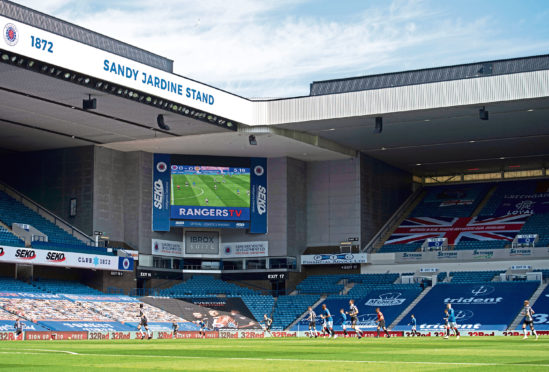
Much like regular life, football has been full of chat about the new normal.
Through the dog days of the shutdown, there was a yearning for the return of games on TV.
Get that back, the logic went, and everything else would be fine again.
Which it was – sort of.
First, it was the Teutonic novelty and efficiency of the Bundesliga.
Then came the English Premier League, which had the benefit that you actually knew all of the teams and most of the players.
If you wanted something a bit more exotic for the weekend, there were games from a host of other countries available on the far reaches of the satellite schedule.
Not Scotland, of course.
But let’s not open that particular can of worms, sat inside a nest of vipers.
Fast-forward a few discombobulating months, and not only are our games back, but we are on the verge of getting actual fans in to see them.
A door that has, up until this point, been firmly closed is about to swing open, just a little bit.
On Saturday, two games – Ross County v Celtic and St Mirren v Hibs – have been earmarked to be trial events.
That will mean socially-distanced crowds of some 300 people allowed in.
It should go without saying both are dependent on the level of the Covid-19 numbers in the local areas.
Unfortunately, the current situation in Glasgow led to Rangers being unable to host fans for the visit of Dundee United.
However, even if just a single game is able to take fans in, the experiment will be a fascinating one.
For starters, only home fans will be able to get in, a big change for anyone raised on a situation where there are always fans of both sides represented at every game, right down the divisions.
What effect is that likely to have on the action?
If all 300 Ross County supporters at the Global Energy Stadium in Dingwall, for example, howl at the referee on Saturday to give a foul for their team at once in an environment that is otherwise much like a training game, is he likely to be swayed?
Welcome to our world, fans of every other team outside Celtic and Rangers are sure to say.
There has already been plenty of speculation about the effect playing without fans has had on the game.
The early German action featured a higher than usual number of away wins, suggesting home advantage is diluted when the vocal backing of supporters is absent.
In England, it has been claimed referees are less likely to reach for their cards without fans screaming for action.
With no background hubbub to soften their impact, screams from players fouled were more likely to win a free-kick and a caution for the offender.
In Scotland, however, the early evidence suggests “the new normal” is pretty much, well, normal.
Over the first half-dozen Scottish Premiership closed-door fixtures up to the international break, there were eight red cards dished out to players – exactly the same total as there were at this point last season.
In 2019/20 there were 15 away wins in the opening six rounds of games.
This season there have been 14, though with Celtic and Aberdeen both having a couple of outstanding fixtures to catch up on due to their breaches of coronavirus regulations, the number could again end up level.
What players and coaches will really hope it that the trial crowds bring back what they have been really missing, which is – from minute one to minute 90 – the sense they are participating in a proper professional football match.
In an interview in these pages, former Motherwell and Partick Thistle defender Steven Craigan testified the UK’s very first test event – the Northern Irish Cup Final which let in 250 fans from each of Glentoran and Ballymena – delivered some of that.
A few hundred in at Ibrox is not going to create the same atmosphere as 50,000. No one is going to be kidded about that.
What it will represent is a step along a path that will eventually lead to something like normality, or what we can remember of it anyway.
In these times where the “new normal” is a diet of change, that is about the best we can hope for.

Enjoy the convenience of having The Sunday Post delivered as a digital ePaper straight to your smartphone, tablet or computer.
Subscribe for only £5.49 a month and enjoy all the benefits of the printed paper as a digital replica.
Subscribe